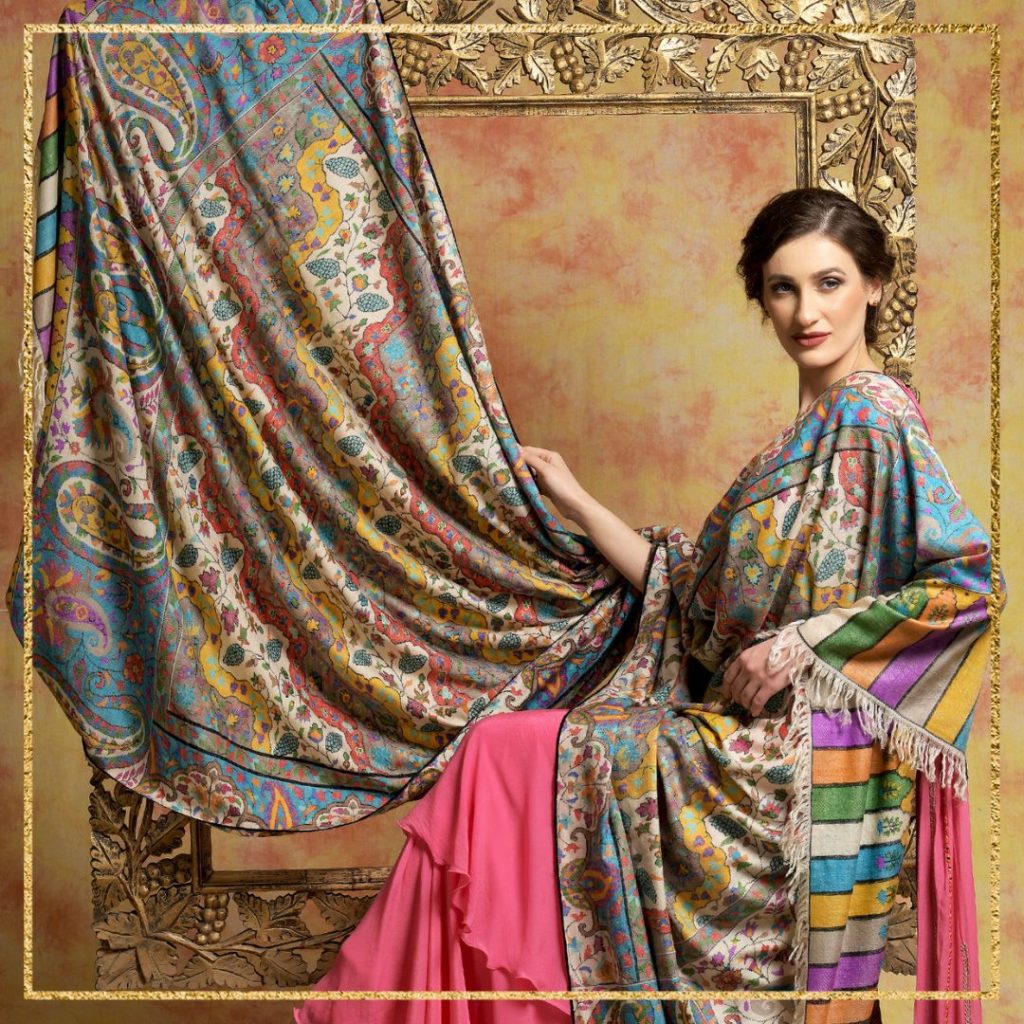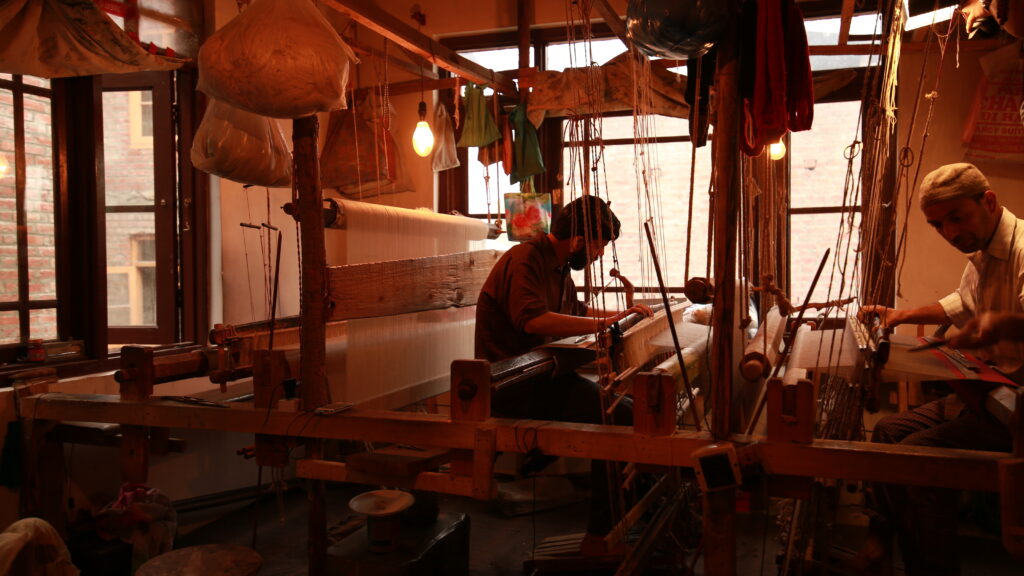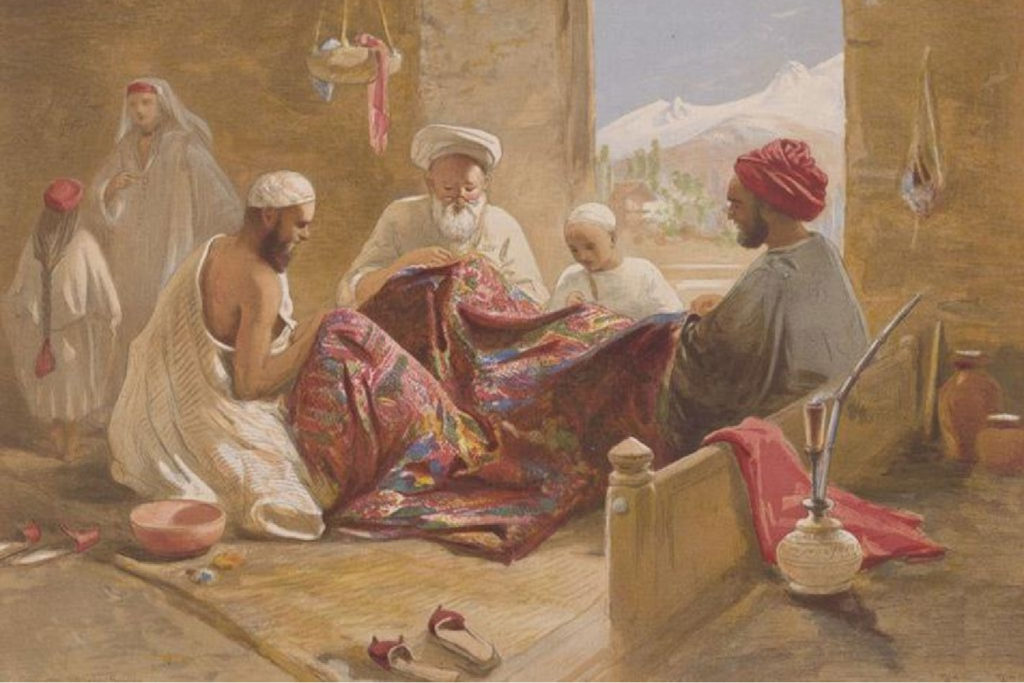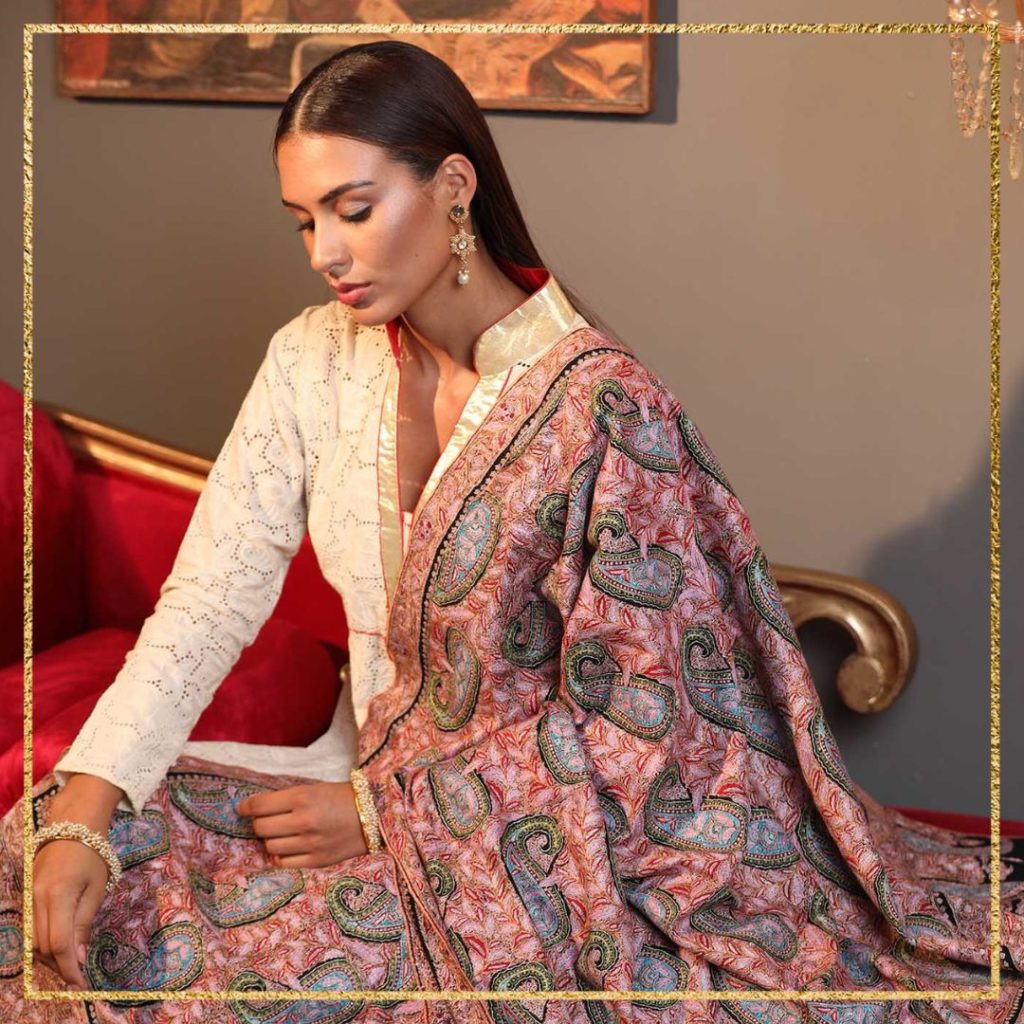It was the second half of the 18th century when Europe saw the rise of a new garment. It was a wrap, which was unconditionally soft, warm, and light. The patterns this new wrap hosted were yet to be seen by Europeans; for that matter even those produced by their local artisans. This product was the Kashmiri Shawl. Kashmiri artisans handcrafted it out of raw Cashmere wool.
The Kashmiri shawl was alluring and pleasing to the eyes. Its quality was simply unmatched. Owing to its qualities, it was used as a status symbol by the royal women of Europe. Among them was the fashion icon of Europe, Empress Josephine, who set it to a timeless fashion after owning hundreds. Later it was Queen Victoria, who further solidified its popularity among the rich, influential, and nobles.
Due to their popularity, India and the West became partners in the trade of these shawls. Large numbers of Kashmiri shawls traveled all routes to reach Europe. A large number of local European companies, who attempted to copy the design of Kashmiri shawls also flourished. The next six decades, starting from the early 19th century, witnessed an obsessive patronage of the shawl. As a result, the original Kashmiri shawls adapted to local design, and henceforth, much changed in its patterns and looks.
What is the Kashmiri shawl?

Kashmiri shawls are handmade wraps that women wear around their shoulders. These keep away cold or simply aggrandize an outfit. Some common synonyms of the Kashmiri shawls are: Pashmina shawl (shawls made from Cashmere), paisley shawl (a famous motif), & more. The name of the Kashmiri shawl varies as per the material used, the motifs used the place it is made or the technique with which it is crafted. As far as the material used in Kashmiri shawls is concerned, these can be:
woolen shawls,
Pashmina shawls, and
Shahtoosh shawls.
As far as the weaving technique is concerned, Kani shawls rule the world of textiles. And on the basis of motifs and patterns, Kashmiri shawls are paisley shawls, Jamawar shawls, Jaalidaar shawls, and more.
The most famous Kashmiri shawls are, however, the Pashmina shawl and the Shahtoosh shawl. Both these shawls come from the down fibre of rare animals, which is the finest and softest. Pashmina shawls come from Pashm, a fleece growing on the body of a Pashmina goat of the Ladakh region. Kashmir is independent of any other nation as far as the production of Pashm wool is concerned. All the produce comes from the goats of Ladakh, who grow just 150 grams a year.
The wonders of Shahtoosh
On the other hand, Shahtoosh is another category that was once reserved only for the Mughal kings. The fleece for making the Shahtoosh shawl comes from the Tibetan Antelope (chiru). It is the finest in the wool industry. This animal is, however, endangered now due to their low population. Trading in or buying Shahtoosh shawls is forbidden. These are no longer in use, which makes Pashmina shawls the most preferred ones. Nevertheless, neither of these has a substitute, and both have reigned long during their times.
The Quality of Kashmiri shawls

The demand for Kashmiri shawls always exceeded the supply. This was because of the unmatched quality and weaving techniques that Kashmir had a monopoly in. The high-quality textiles and the unparalleled skill of local artisans made it possible for Kashmir to enjoy the ownership of being the best producer of shawls. Kashmir had geographical advantages, and hence it was now a center of high-quality textile production.
Distinctive weaving patterns and wonderfully fine wool combine to produce a Kashmiri shawl. As a result of these factors, Europeans were fascinated with the quality of Kashmiri shawls. This resulted in immense demand for these pieces. When the demand was higher than the supply, some traders and manufacturers started making fake and copied shawls. But even these sold out on a large scale. However, these could never compete with the art of the original artists - the Kashmiri shawl makers. Kashmiri artisans had an unmatched skill. Even if one tried to copy, he would fail.
The Rise of the Paisley Motif

The Paisley motif or the Buta as it is locally called, became the most well-known and used motif when it came to Kashmiri shawls. The paisley motif is like a teardrop and has ancient origins. It has been in use since the Mughal period. Since then, however, it has changed its shape many times, owing to the changes in fashion. Before the Europeans made their own version of this motif, Paisley looked like a teardrop. Paisley is the western name of the Buta motif. It is derived from a town in Scotland, called Paisley. This town became the largest producer of imitation Kashmiri shawls featuring the Paisley motif.
Historians have suggested a number of versions of this motif that was mainly used in Kashmiri shawls. While some claim that the motif is inspired by cypress trees in pre-Islamic Iran (cypress was a significant symbol back then), others suggest it is just a floral design. But Europeans changed the shape of the motif according to their own understanding of its history. Many changes occured in its design to fit its own customer base.
Till the 1800s, the paisley motif existed on almost all patterned shawls and took the bordering place mostly. But Europeans made it clear that shawls could even be patterned with Paisley motifs all over their base. With the invention of the jacquard loom, it became more possible as the loom could produce patterned shawls easily.
Kashmiri Shawl before Europeans took over
Kashmir had always been under a number of cultural influences because of its geographical location. I shared borders with Persian civilizations and the Islamic world, Tibet, the Himalayas, and India. Hence it would come under the sway of different cultures and rulers. Each one would contribute one feature or the other to the local handicrafts. As a result, Persian, Hindu, Sikh, British, and other cultures directly influenced Kashmiri culture
As far as the glory and zenith of the Kashmiri shawl are concerned, it was during the reign of Sultan Zain ul Abideen. He ruled from 1420 to 1470. After that when Akbar came to rule in around 1586, the shawl experienced newness; the current rule brought their own innovations into the designs. The Kashmiri shawl has mention in the autobiography of King Akbar - Ain I Akbari - written by Abu Fazl. The book acknowledges the Emperor's love and reverence for Kashmir shawls, especially for Shahtoosh shawls.
Shahtoosh and Pashmina Kashmiri Shawls
Shahtoosh shawls experienced a different level of reverence and adoration from kings and commoners. It was called the ‘ring shawl’, as it could be passed through a finger ring. Shahtoosh shawls were a luxury item and signified rank and status. These were also given to diplomats as gifts, as well as to nobles as a mark of high service, great achievement, or simply a royal favour (khilat). The receiver would automatically become a subordinate, and the giver an autonomous power, in some cases. However, a large number of researchers believe that it wasn't Shahtoosh, but Pashmina shawls that were presented as khilat. The culture of gifting Pashmina shawl remained even after the Mughal rule diminished.
Early Europeans, who visited the valley, were much confused about the culture of Khilat. But as they spent time with the locals, they understood how graceful of a tradition it was. Soon they started doing the same with their counterparts. As a result, by the 18th century, Kashmiri shawls spread their wings over larger areas, not just Kashmir or India. It was a well-established handicraft of Kashmir - luxurious and high style. Its makers were considered as one of the most skilled communities on earth.
Kashmiri shawl arrives in Europe
The most common belief of scholars is that the Kashmiri shawl was introduced in Europe by Napoleon when he was on a campaign in 1789-1801. It was he who purchased a Kashmiri shawl (Kani shawl), and on his return to France. He then presented the same to his wife. Being a style icon, and world-famous for her classic taste, Josephine was able to set the shawls to a timeless fashion. She owned over a hundred shawls and made them the most iconic accessory of those times.
However, a large number of researchers do not agree with this. They argue that Kashmiri shawls in Europe preceded this story and that Napoleon and Josephine already knew about Kashmiri shawls. It might have been the East India company that introduced Kashmiri shawls in Europe. The officials of the East India Company would have sent some shawls to their hometowns as gifts back in the 1700s, and that would have been the start of it. Officials might have experienced the luxurious nature of the shawl and gifted it to their wives while returning back to their countries.
As a result, a large number of regions in Europe started replicating the shawls. Surprisingly, even replicated shawls picked up the pace. This was especially with the less privileged women who couldn't afford the high-priced original shawls. Nevertheless, original Kashmiri shawls were mostly worn by high society women, rich and affluent nobles, and wives of ruling kings and Emperors.
The Paisley Motif

A major symbol in the Kashmiri shawls which were popular in Europe was the Paisley motif, locally called Buta. Many Europeans believed that the Kashmiri shawl is the Buta shawl, and used these two terms synonymously. Nevertheless, the quality of the original Kashmiri shawl was never matched. This was primarily because of the absence of Pashm and the unmatched skill of Kashmiri artisans. For this reason, the British became desperate to acquire the Pashm-producing goats. So, as a part of the treaty of Amritsar, the victorious Britishers forced the Sikh empire to pay an annual tribute of 12 shawl goats.
An episode like this had taken place some time back. Decades prior to this episode, Willian Moorcroft (an English explorer) traveled to Kashmir and decided to sneak 50 goats to England. Unfortunately for them, just 25 male goats made it to England. But these goats could not produce fine Pashm owing to the difference in climatic conditions of England. Hence Kashmir retained its monopoly of producing the finest Pashmina shawls; the world had to compromise on being the buyers rather than producers.
The popularity of the Kashmiri Pashmina shawl endangered the shawls all around the world. The demand rose so much that around the 1800s, Kashmiri artisans produced new designs and techniques that were directly influenced by Europeans. Administrators came from France and took charge of the industry, thus introducing a large number of French patterns. This was done to fulfill the tastes of locals as well as European customers
The Fall of the Shawl
Around the 1870s, several factors led to the decline of the Kashmiri shawl as well as its western copies. A large number of fashionable capes and jackets took over. This decreased the humongous demand for the shawl day by day. Another reason for the decline of the shawl was the Franco-Prussian war. The war led to a disruption in trade between Europe and the world, including Kashmir. Kashmir also experienced a famine in the 1870s which led to an economic crisis. This made the artisans in Kashmir quite weak, and some even died as a result.
This led to a severe drop in production and hence the sales of Kashmiri shawls. As a result, Europeans embraced machine-made shawls. The Kashmiri shawl industry continued dipping, and never really recovered from this production famine. It is the recent times that the shawl industry has gained impetus again. It is now that workers started mass production of original Kashmiri shawls.
Also read: HOW CAN YOU TELL IF A CASHMERE IS REAL?
Concluding
The story of Kashmiri shawls shows the changes it went through. From being a luxury piece of wrap of incomparable quality, the shawl became an everyday accessory for the middle class. Some believe it was industrialization that rendered this precious fabric a common wrap that everyone could use regularly. What was once an elite Mughal possession could now be seen in every nook and corner of London, New York, and Paris. Moreover, it cost them a little more than any affordable accessory.
Also read: 20 MOST ASKED QUESTIONS ABOUT PASHMINA AND CASHMERE